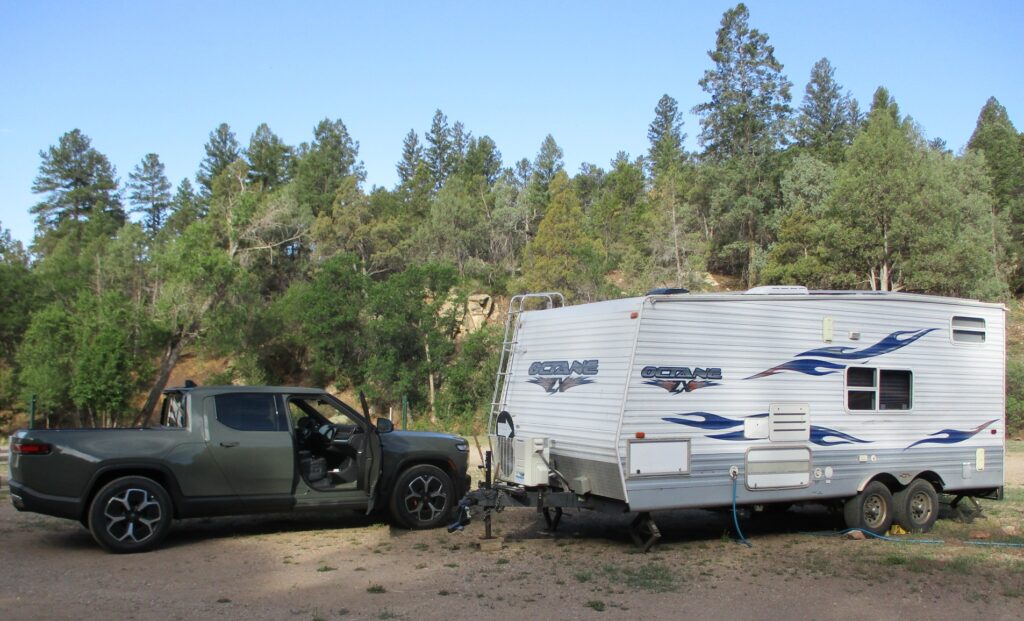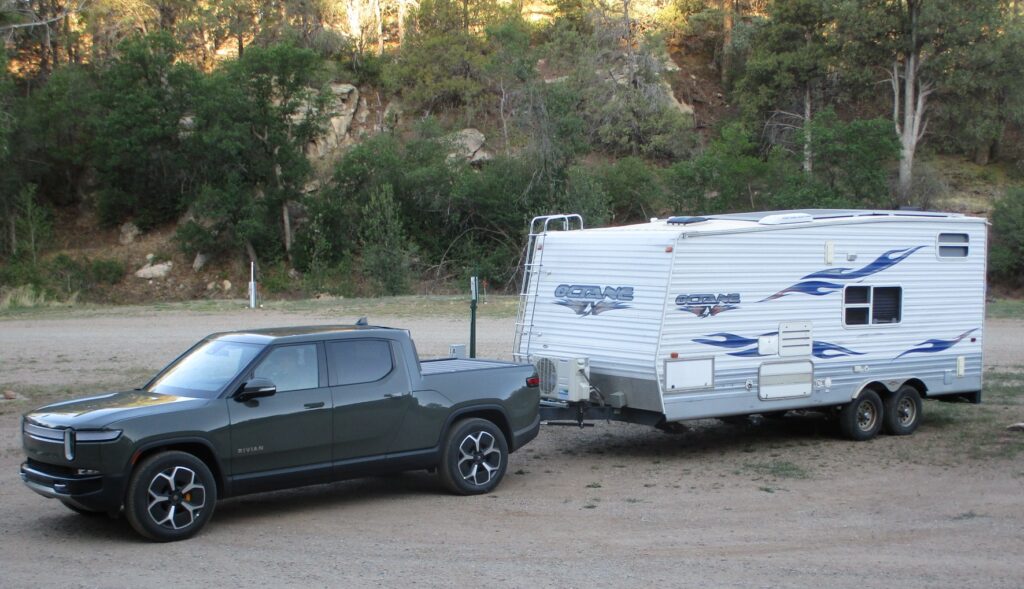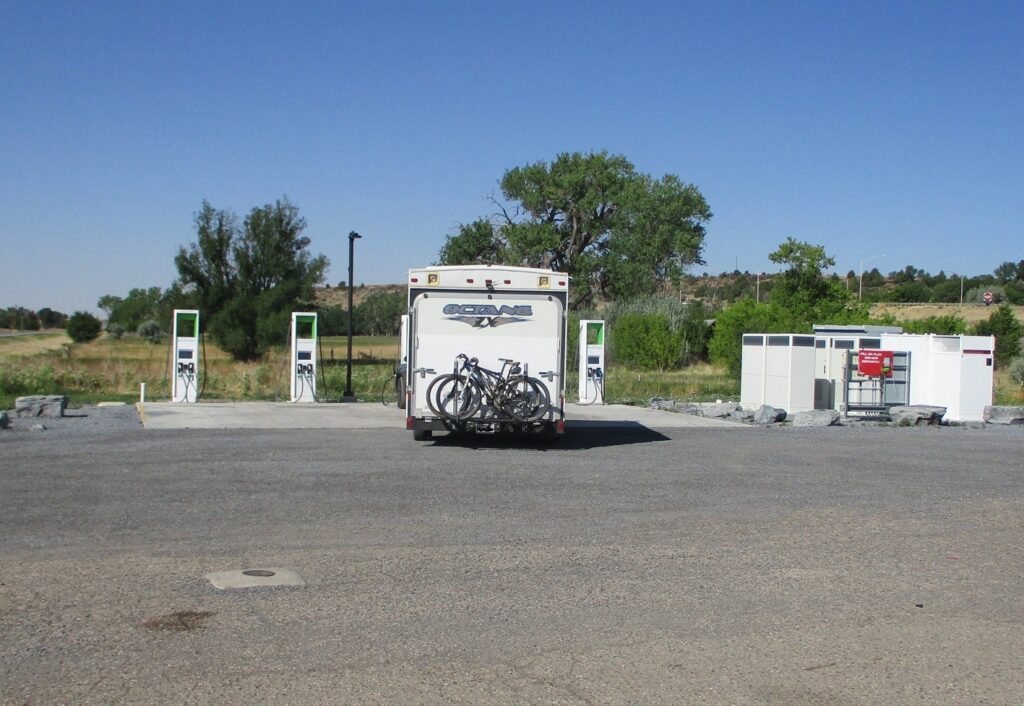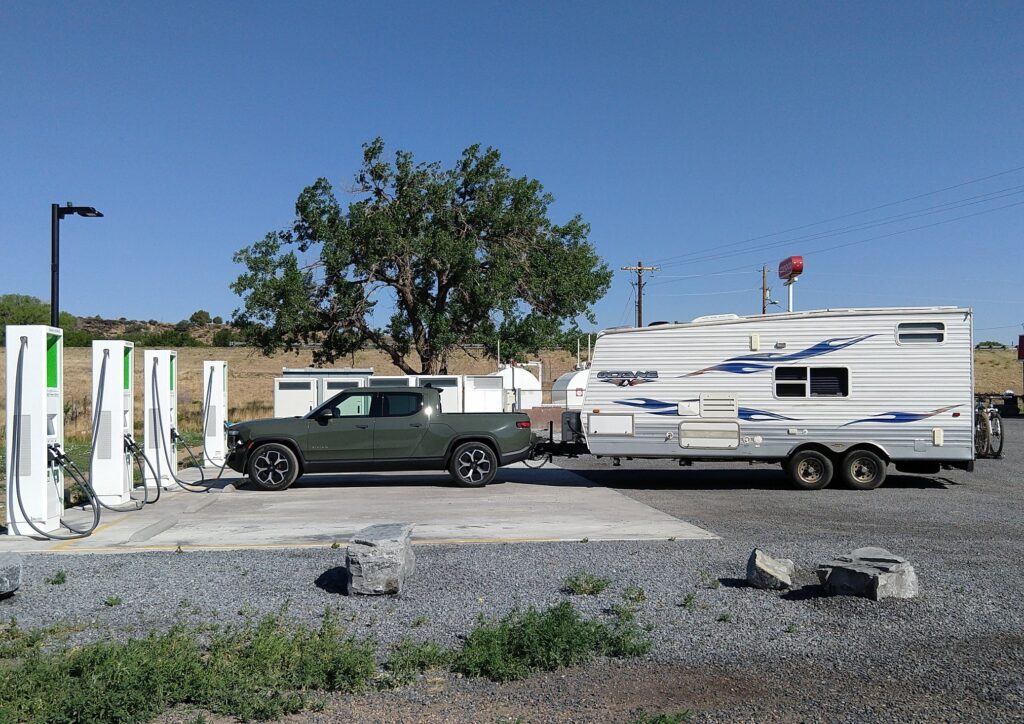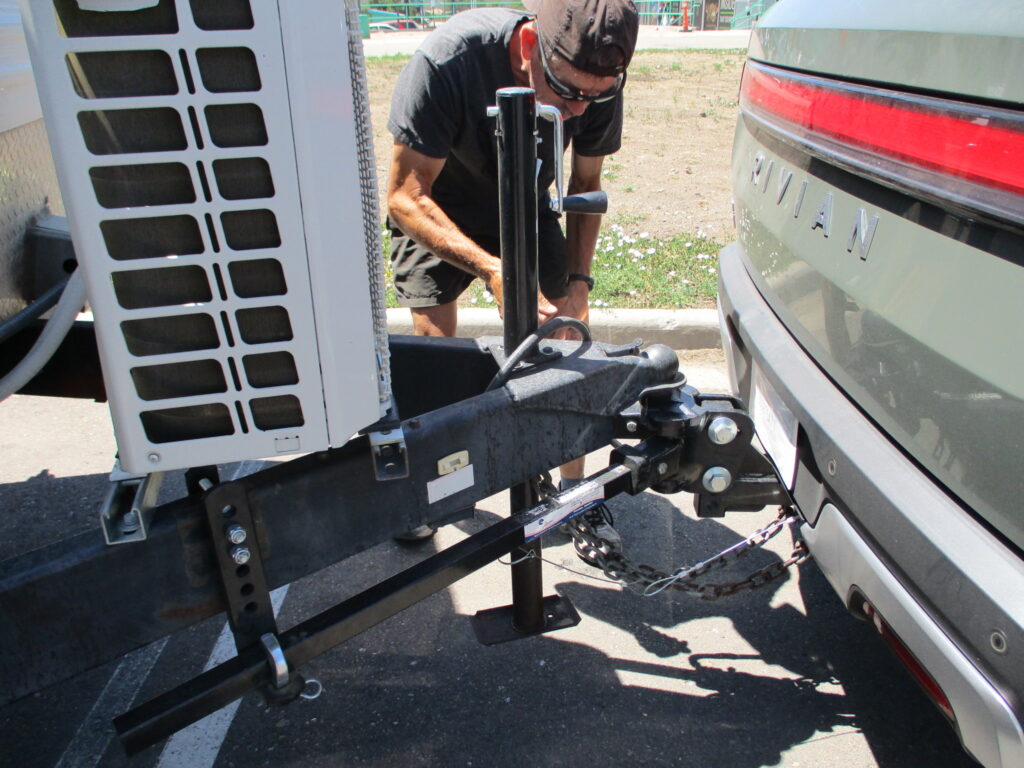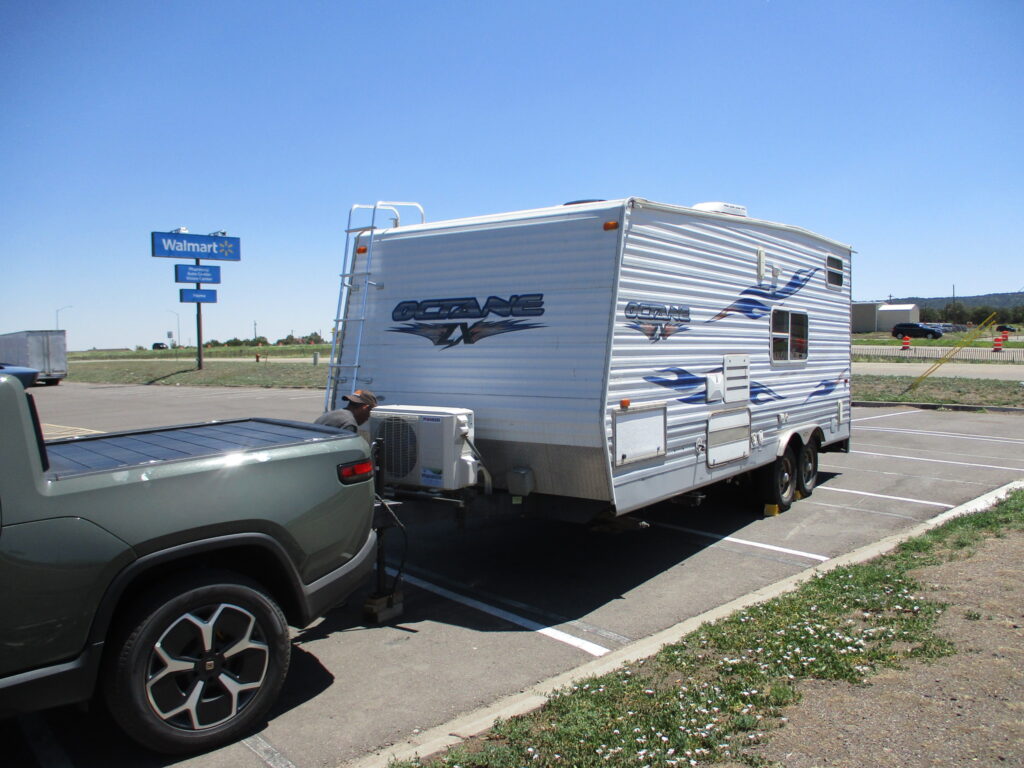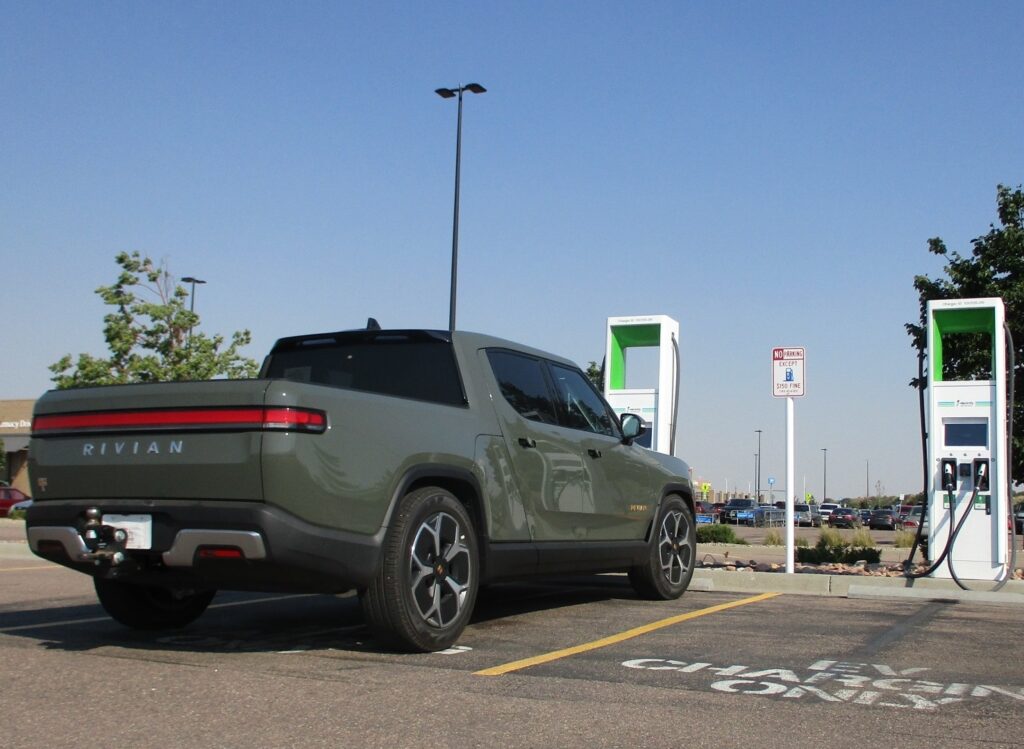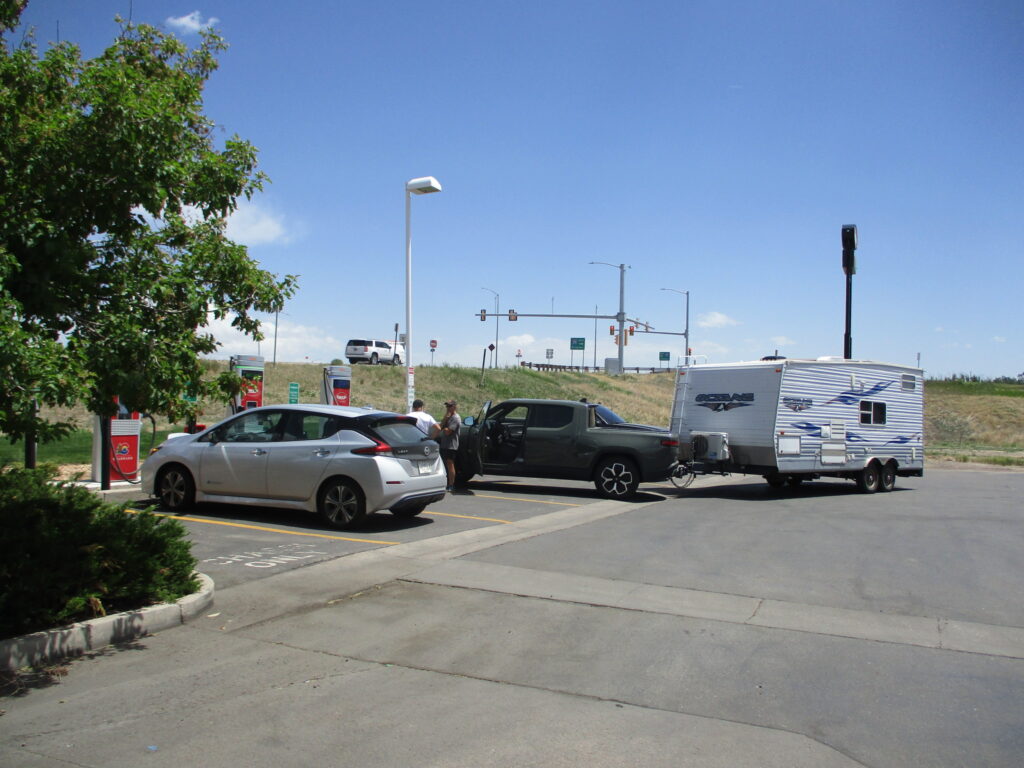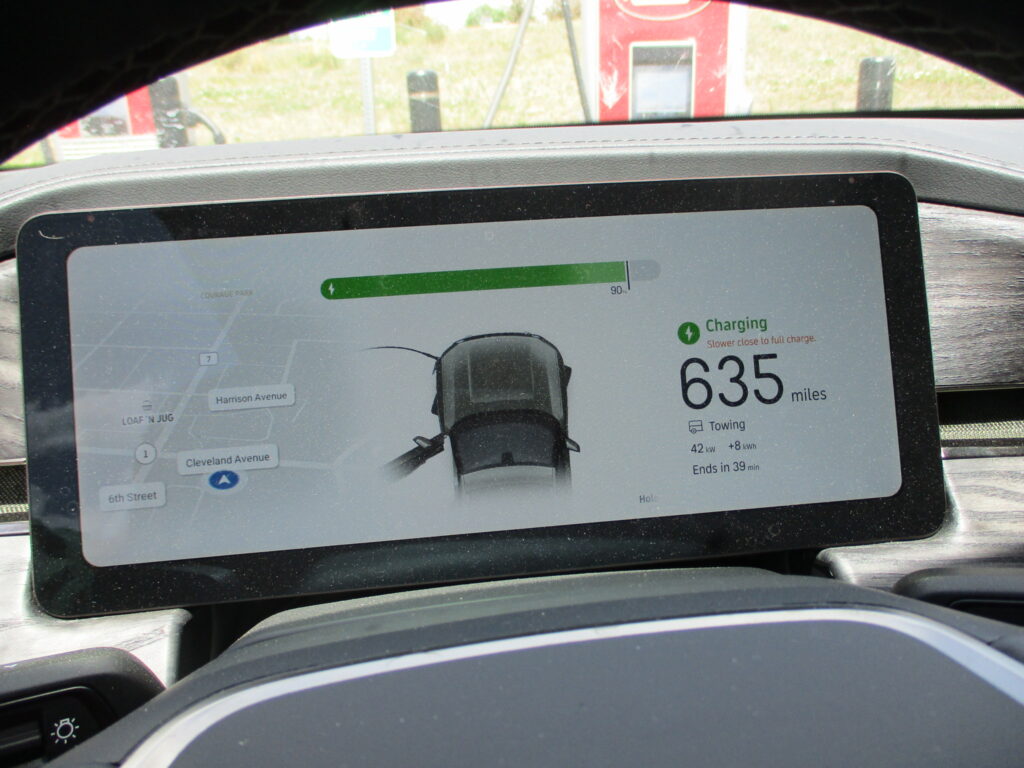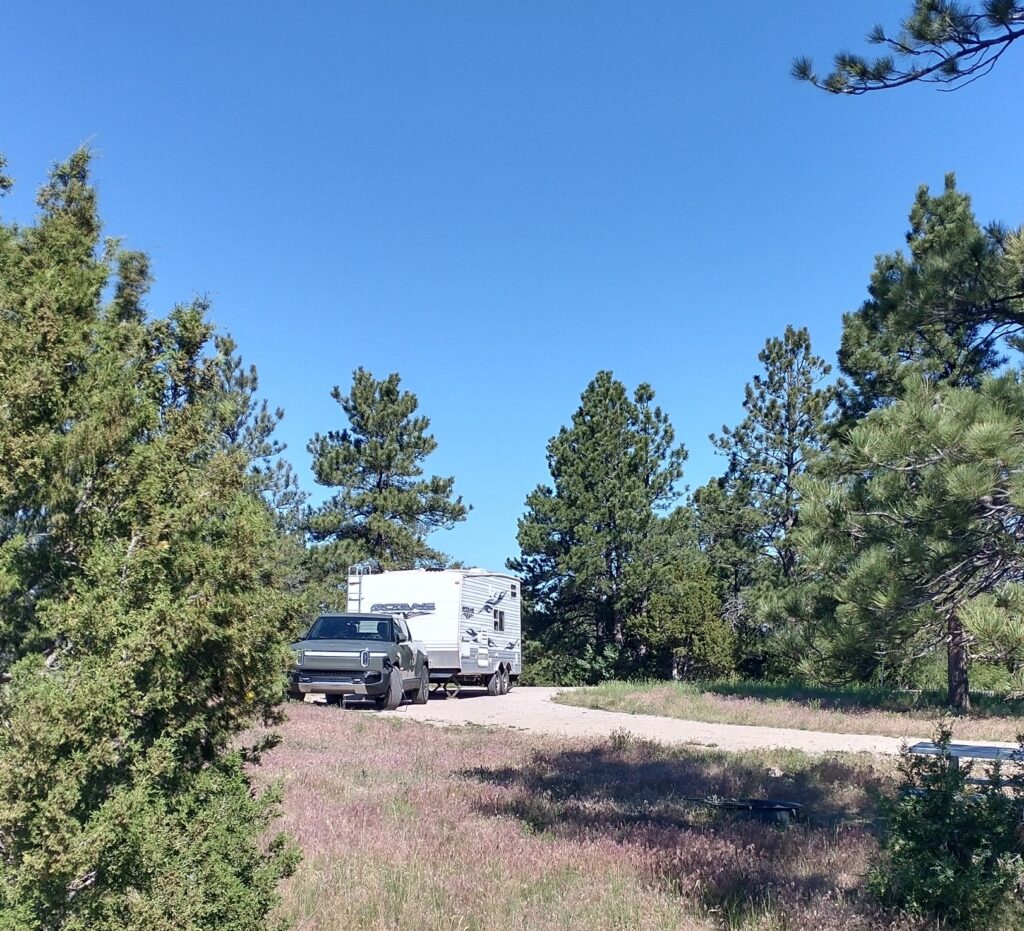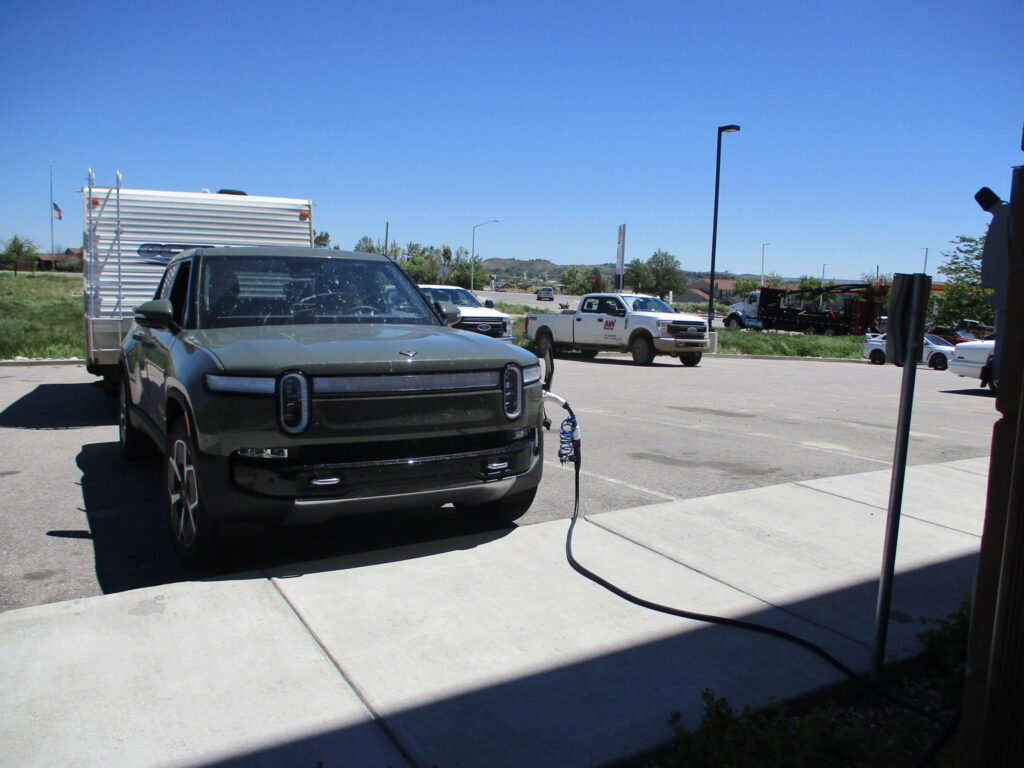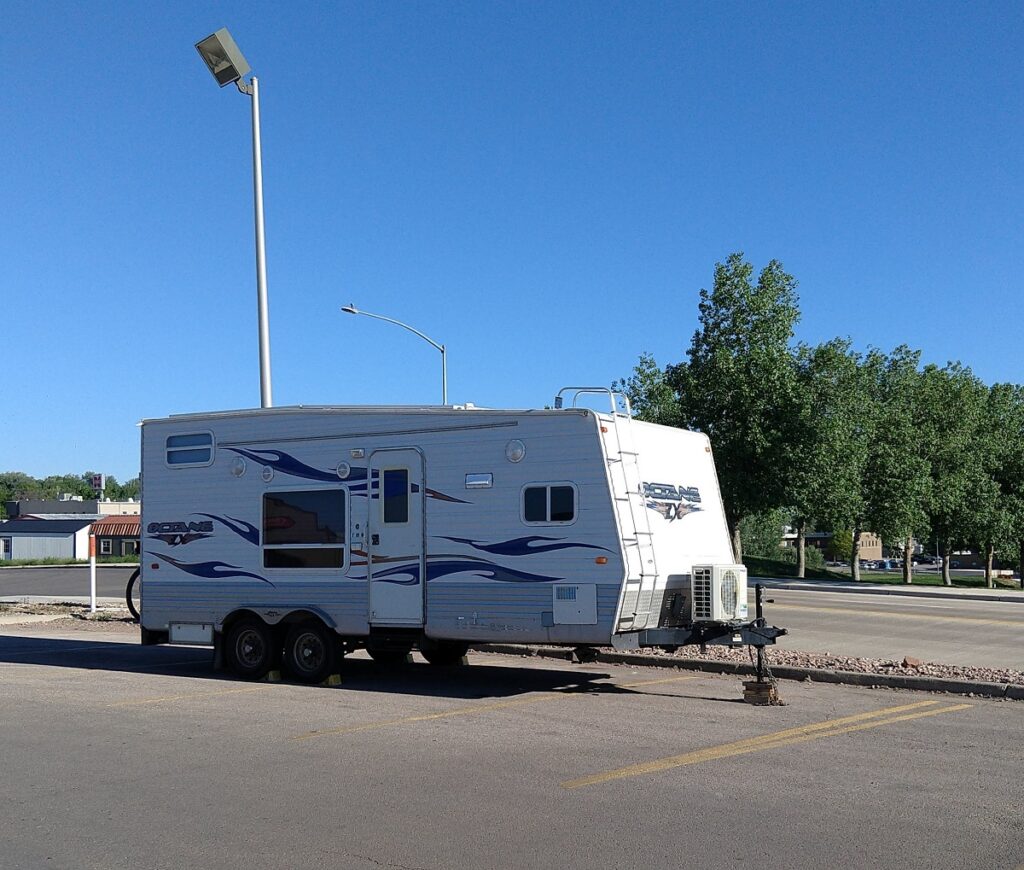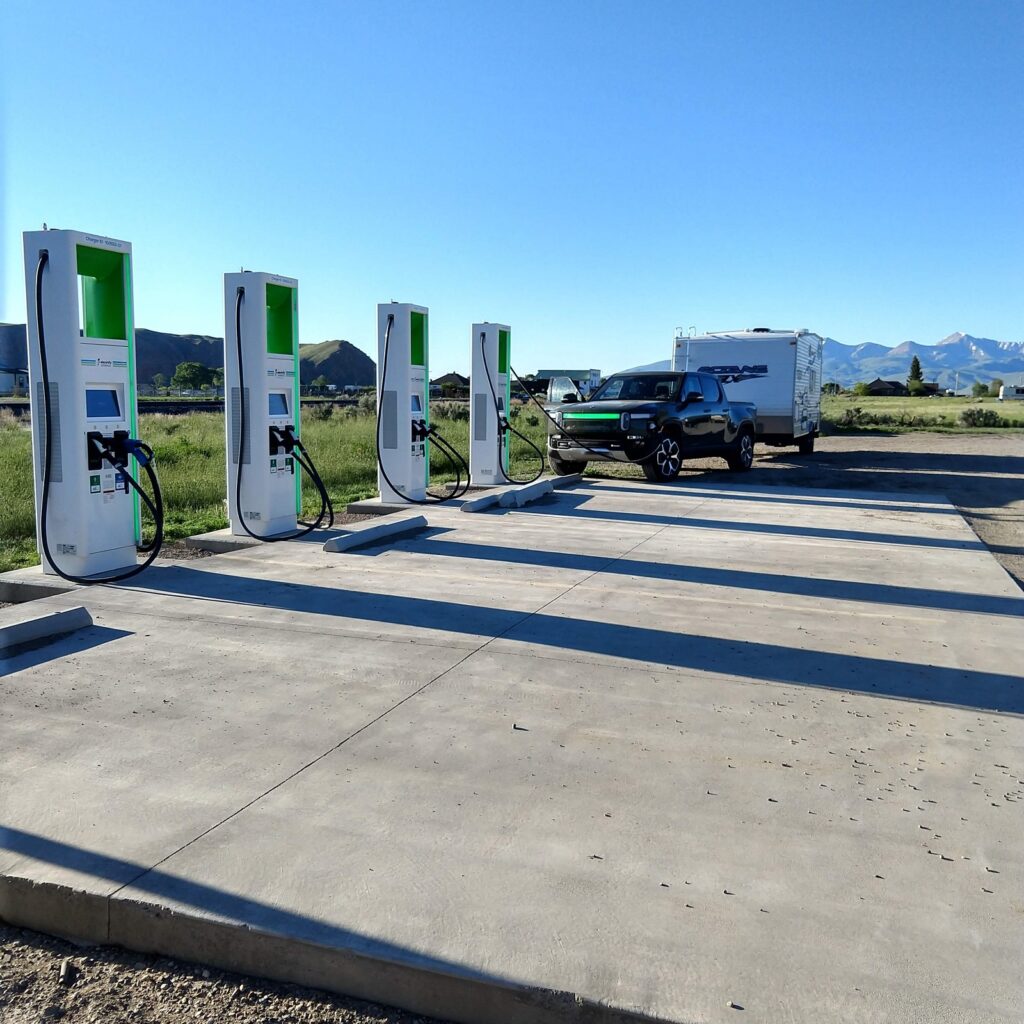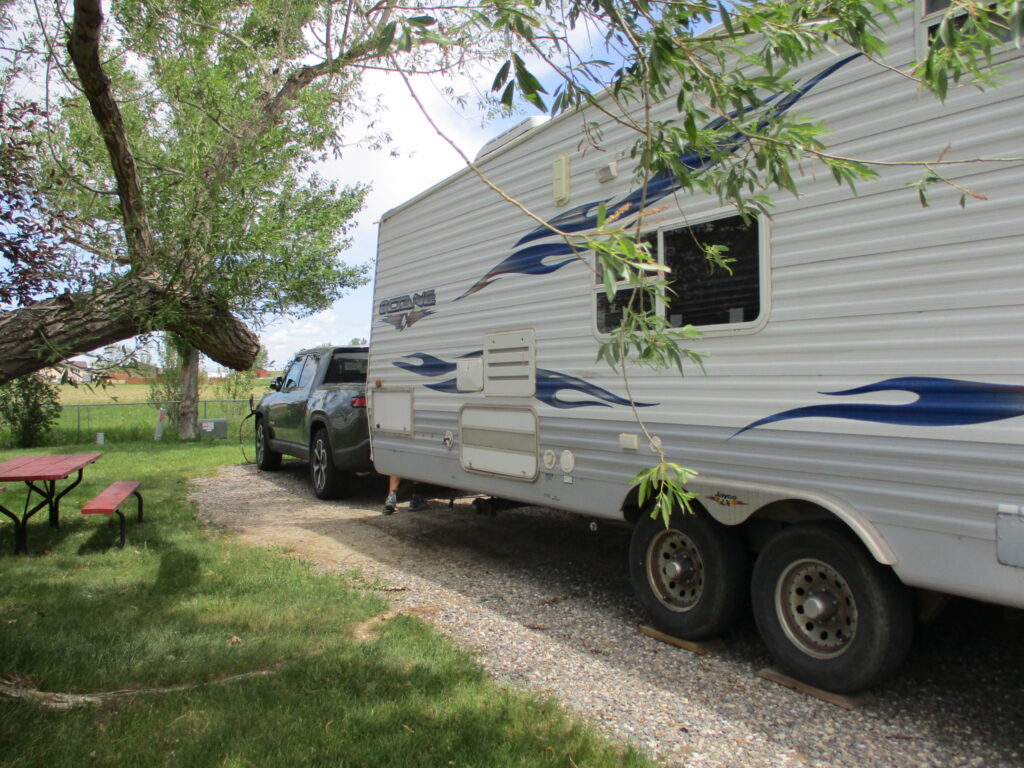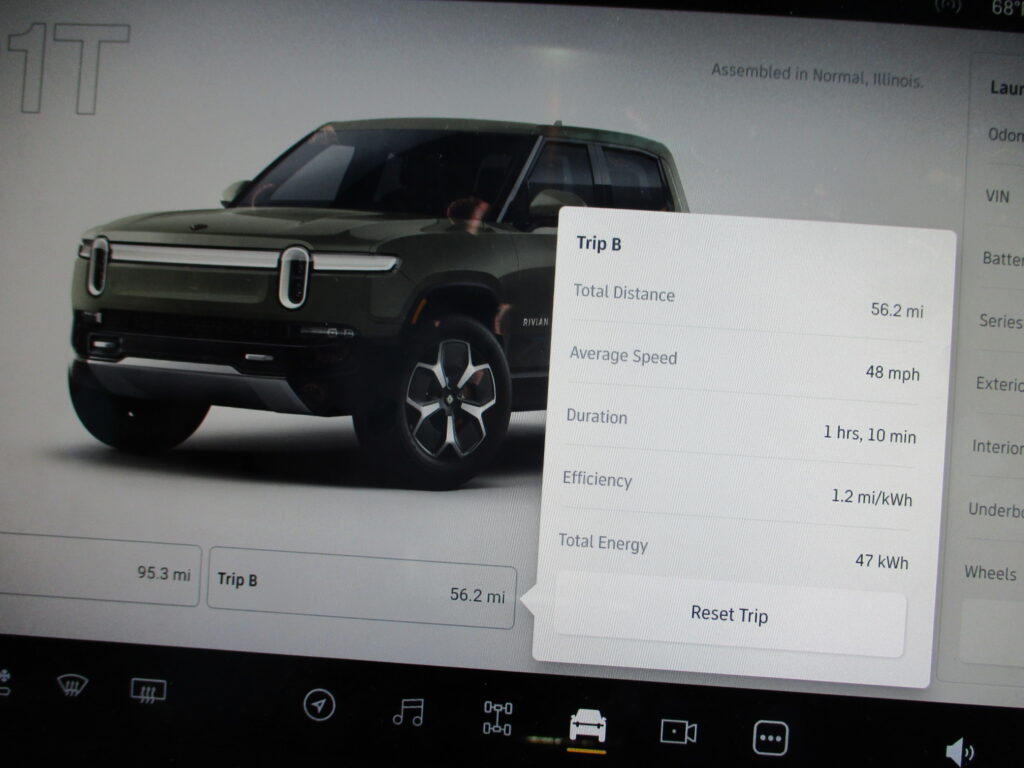Three years after placing our Rivian R1T pre-order and a few months after they began shipping the first trucks, we got an email saying that ours was ready! It was time to begin this “All-Electric Project” for real. It was also time to find out how feasible (or not) it would be to tow our house and all our possessions. This is the story of our first electric truck towing experiences last summer.
I flew to Normal, IL to collect Tug-E (so-named as the electric replacement for old Tug). In my personal blog I describe that journey with more pictures and stories. I love driving the Rivian – it’s easy to drive, quick in every way, quiet and lovely, and an engineering marvel. The biggest change from our excellent Bolt EV is that it’s larger and therefore not as simple to park. We make good use of the overhead camera view when maneuvering in parking lots. Other than that, traveling in Tug-E by itself is a dream. Switching to EV’s was one of the best decisions we’ve made.
We returned to New Mexico to collect our travel trailer. Tug-E and Howie hit it off right away:
Tug-E has less space that old Tug, so John spent some time sorting his tools and truck gear, while I pulled some unused items out of Howie to give him a bit of room inside. We are finding the Rivian gear tube and front trunk to be especially handy and accessible as storage areas. Future possibilities include adding a cap on the back or mounting a tent platform on the bed. It would be nice to eventually be able to sleep in (or on) the truck like we’re used to.
The Rivian comes with a 2″ hitch receiver and a 7-pin connector, the exact configuration we need. Our hitch is barely long enough to fit without running into the bumper, happily a plug-and-play situation.
We were somewhat amazed that the first hook-up experience went so well. Shall we get on the road and try some long-distance towing right off the bat?
Cautiously we started down the highway, pleasantly surprised at how easy it was. The truck tows like a boss. It has power, stability, and adjustability to road conditions. We can quickly forget that there’s a big box in our wake. That includes starting from a dead stop and accelerating to make a pass. Integrated braking is part of the function of the 7-pin connector that sends a “slow down” signal back to the trailer brakes.
The side mirrors aren’t quite wide enough to see very far around the trailer, although John has adapted. It helps that we finally have a working camera on the back of Howie. Perhaps we can find an after-market option for side mirror extenders.
The first leg of our trip was easy – 89 miles on I-25 with a 1300-foot elevation drop and no significant wind. That took 49% of a full battery (1.49 miles per kWh), no problem.
We even got lucky that our first charger of the day had a huge parking lot with a ton of space to work with, so we could pull straight in:
I wish all chargers were this easy (well OK, a pull-through would be even easier, if we’re asking for miracles):
Next up was Raton Pass, 84 miles that included a 1600-foot climb and similar descent. By this point there was a tailwind helping us along. John took it rather slowly, mostly going around 55 mph on the highway, and the ascent went fine. The drop on the other side added some energy back to the battery (thank you, regenerative braking!) and the overall efficiency was still decent at 1.27 miles/kWh, using 53% of the battery.
There is a legitimate concern about range when towing Howie. The trailer weighs around 8000 pounds (we need to get a more current weight) and its shape is not exactly aerodynamic. We were hoping for a drop to perhaps half of the non-towing range. Anything less and it would be quite difficult to travel around the country.
It helps that the non-towing range is 320+ miles, on the higher end for current electric vehicles. Of course, we were spoiled with a Dodge Ram that had 600 miles of range on a tank of gas, which dropped to 300 miles when towing. Hopefully someday there will be EV’s with similar capabilities.
Tug-E has towed Howie for over 100 miles at a stretch, which works well enough for now. There are still challenges. Finding fast chargers where we need them is the obvious one. If there were as many fast chargers as there are gas stations, this would be a non-issue. The other difficulty is predicting variations in range. Sometimes 100 miles is easy, sometimes it’s a big stretch, and occasionally it’s not possible. As you might have guessed by now, I’ve started collecting data and trying to make correlations to help with this. I’ll go into more detail in future posts.
Briefly, factors that affect range to some degree include elevation changes, wind speed and direction, temperature, driving speed, driving habits, interior AC/heating, and I’m sure there are other things I’m not thinking about yet.
So it would be great if we could always expect 150 miles of range, but my prediction models aren’t ready to try for much more than 100 miles at a time, just to be safe.
Back to our initial towing tour!
We made it easily to Trinidad, finding a common charging situation with Electrify America chargers at a Walmart. Those are almost never set up for towing, but at least there is usually space further out in the large parking lot to drop the trailer.
John got some practice unhooking and re-hooking over the next few days. First thing he did was reposition the bolts on the hitch to adjust the height so the trailer would ride slightly higher. Getting set up to unhitch:
A typical spot for dropping Howie:
The truck facilitates this procedure, unexpectedly. It has several modes including Sport, Conserve, Off-Road, and Towing. Each mode has multiple height options, ranging from 8″ to 14″. It didn’t take us long to say “Hey! Can we use that to our advantage?”
And the answer is yes, yes we can. Instead of manually raising the trailer receiver off of the hitch ball, John can raise it enough to unweight it. Then we lower the truck to get out from underneath the receiver and drive away. We reverse the process to hook up – lower the truck, slide in under the receiver, and raise the truck back up. It doesn’t completely negate the work of lifting and dropping the trailer, but it does help. And it still makes us smile.
Side note – we are aware that electric jacks exist. John is still happy getting a bit of extra exercise, and who am I to argue with that.
Tug-E charging at another Walmart later the same day:
Our DC fast charging sessions typically last around 30-80 minutes, a nice amount of time for a pit stop, a snack or a meal, shopping, and/or a walk-around break. The length of time depends on whether we need 100% recharge vs. being OK with around 80-90% battery for the next section. Charging speed slows down significantly between 80% to 100% state of charge, so if we don’t need that much it isn’t usually worth the wait.
The great thing about taking the travel trailer along is that we have our house with us. We can drive for an hour or two, stop to charge and eat an at-home breakfast, continue on for a while, have lunch at our normal table during the next charging session, etc. I turn on our WiFi device and do a bit of computer work. I could even go for a run in town and then take a shower. It’s just a different way to design the day.
We continued north through Denver, finding plenty of charging options in Colorado (although Pueblo needs improvement). Wellington even has a location that allowed us to stay hooked up, only because it wasn’t too crowded at the time:
John enjoys talking with people who are curious about the Rivian, which is good because it happens all the time. Especially when our trailer is involved. We’re not normally attention-seekers, but EV’s and electrification are topics we could ramble on about. Making Howie into an all-electric travel trailer is wonderful but not highly visible. The Rivian is also wonderful and tends to stand out.
While we were charging I noticed that the software wasn’t reading exactly correctly – we only wish we could get 635 miles of range, especially in tow mode! I believe a software update has since fixed this glitch:
Next up was Wyoming, which has a ton of potential in terms of adding EV chargers. In other words, currently a challenge in our situation.
We drove 103 miles to Wheatland, tacking into a side wind that dropped our efficiency to around 1.0 miles/kWh. With another 37 miles to go and probably not enough left in the battery, we pulled into town and found a level 2 (medium speed) Tesla destination charger at a hotel. Thankfully the hotel people didn’t mind us using it. We’d bought an adapter just for this purpose and it has come in handy several times.
A medium-speed charger is a lot slower than a fast charger, better for overnight sessions but still better than nothing. We parked at the hotel for almost 3 hours, added 19 kWh, and decided that would hopefully be enough to get us to the next campground.
There wasn’t a lot of traffic on the highway, so John drove 45-55 mph without feeling like we were in the way. The road to the campground was mostly downhill and we effectively coasted to our campsite on fumes. Or electrons. That was more stressful than we would have liked, but we made it!
Glendo has a lovely state park near a lake with quiet sites in the woods (and electric hookups):
Our Rivian came with a charger that can plug into a 50A RV post (14-50 NEMA), and we use it all the time for level 2 charging. This is not a standard EV accessory, but perfect for our lifestyle.
As great as that all sounds, it’s worth remembering that a level 2 charger is medium speed, not fast. We had not fully processed before this moment that it takes more than one overnight to fill up a 135 kWh battery on level 2.
We stayed at our campsite until checkout time the next morning (luckily we were not in a hurry). That was enough to get the battery up to 82%.
Before setting off on our next “hope we make it” adventure, we reconsidered how to handle the 150-mile leg ahead of us. I made a call to an RV park in Sagebluff (110 miles away) and they had a spot open with 50 Amp service. There was still a strong west wind blowing so it was likely our efficiency would suffer.
Therefore we drove 34 miles to Douglas and found another Tesla destination charger. This hotel also had accommodating people at the desk. It probably helps that there isn’t a lot of demand for midday charging at hotels. It was also great that the parking lot was open enough that we could pull right in to charge:
We waited for the battery to go from 56% to 70% and decided that should be sufficient for the 76 miles to Sagebluff. It was a good estimate, as we rolled into the RV park with 6% battery remaining, reasonable confidence that we would make it, and a much better sense of what to expect.
The backup plan, if we ever realize that we won’t make it, is to drop the trailer, drive ahead (or back) with Tug-E by itself, charge up, and return for Howie. We haven’t had to do this yet and we hope to never have to spend the extra time and driving, but at least it’s an option. Assuming we figure it out before the battery drops too low. I’ve done plenty of “EV Math” while driving – and I’d suggest that towing with an EV isn’t for everyone at this point.
We charged overnight to 71% at the RV park, plenty of juice to make it 39 miles to Gillette. Finally, a fast charger to help us traverse the rest of the way to our destination. We were more than happy to unhitch Howie in the grocery store parking lot and to wait for Tug-E to fill up to 100%.
There was even a tailwind on the way to Sheridan, making the next 104 miles simple.
Continuing our tour, we towed Howie through southern Montana, a bit of Idaho and Utah, and spent some time in Colorado before “settling” in Tucson for the winter months. After our Wyoming days, wind was much less of a concern and we instead focused on elevation changes. Especially in Colorado.
A particularly scenic stop in Dell, MT, with the bonus of not needing to unhook:
The truck efficiency averaged about 1.2 miles per kWh while towing, varying from 0.84 to 1.49 (approximately 110 to 190 miles of range). We got better at estimating how far we could go in various situations depending on climbs and descents, weather, and driving speed. We also improved our planning related to RV park locations and had no more concerns about making it to the next charging station.
I added a couple charts to the Progress/Status page, including a summary of monthly truck efficiency while towing and not towing. I plan to delve deeper into towing efficiency in the next blog post.
Our new strategy for EV towing includes the following:
- Aim for fewer miles (and fewer charging sessions) per day. Otherwise we are faced with long and sometimes tiring travel days, especially if we need to unhook multiple times to charge.
- Travel slower. Take access roads and local roads when possible. 55 mph does wonders for improving efficiency vs. 65-70 mph on the highway.
- Following interstates will lead us to the highest concentrations of chargers, especially fast chargers. However, there are still some states that lack chargers in the right places (this link has a map of charging stations in the U.S.). The situation will improve over time as funding for EV infrastructure ramps up, including in rural areas.
- Use RV parks for overnight charging to reduce the number of midday charger stops. State parks sometimes have 50A plugs. We love Harvest Host locations, but they are unlikely to have level 2 electrical hookups. Normally we can boondock all summer if we want, with the amount of solar + batteries in Howie, so going back to RV parks is a shift for us.
Charging at an RV park, where we pulled straight into the site so the truck could access the electrical post:
- Monitor the efficiency as we drive. If we have overestimated truck range, adjust on the fly by slowing down or adding a charging stop:
- Park in one place for a few days and use Tug-E to go exploring. We now have All Wheel Drive! 300+ miles of range without the trailer allows us access to many places we’d like to be. Return and do a level 2 charge overnight.
These ideas should help when planning our “2023 summer towing tour”.
On the plus side, driving long distances in Tug-E is easy. The seats are comfortable, the ride is smooth, and the windows are large (including the one over our heads!). We use the backup and overhead cameras for maneuvering, something new to us although apparently not new to the auto industry. We have individual seat settings by driver, with “kneel when parked” and “roomy exit” options. The GPS app works decently well, and recently they added the ability to receive a location from Google Maps on my phone. So many things about the truck are amazing to us, and everything improves with each software update.
In summary, it now takes longer to travel with our house in tow. We plan for additional days and plan around availability of EV chargers. It’s nowhere near as straightforward as it used to be or should be. As the charging station network evolves, the experience will become simpler.
This is all worth it to us to switch to all-electric living. We are thrilled to have the opportunity to reduce our carbon emissions while maintaining the nomadic lifestyle. However! I wouldn’t necessarily recommend it unless you have a good idea what you’re getting into plus a lot of time and patience. An EV by itself? Certainly yes. Towing your house with an electric truck? It can be done; stay tuned for more details.
